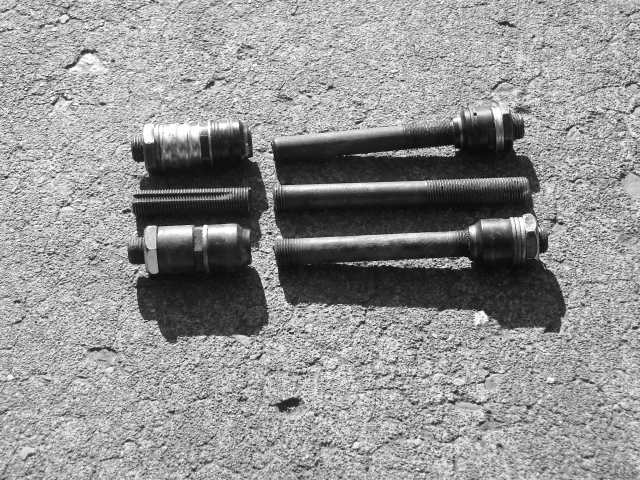 Here is a photo of DT alpine III spokes they are 13 gauge at the elbow 15 gauge at the shaft and 14 gauge at the threads. The shaft on these spokes are 1mm longer than their 14 gauge spokes this make them a poor fit for the hub shown. The 2.3mm elbow fit in every hub I had on hand and in fact they fit loose. Wheelsmith tested 76 spokes to failure and HP Gavin http://www.duke.edu/~hpgavin/papers/HPGavin-Wheel-Paper.pdf came up with a formula to predict the life of a spoke when the gauge is changed. It is Log S = -.3 Log N + 4.12 where S is the stress and N is the number of cycles. Going from a 14 gauge spoke to a 13 gauge spoke will increase the life of the spoke by a factor of 2.5. Since spokes usually break at the elbow The DT alpine III spokes or the wheelsmith or Phil Wood 13/14 gauge spokes are an improvement. The threads of good spokes are rolled instead of cut this makes the outside diameter of the threads of a 2mm spoke 2.2mm. The spoke holes in the flange will need to be 2.2mm or larger for the spoke to fit. In fact they are generally 2.5mm this is poor engineering practice. Studies on rivets and bolts have shown that the tighter the fit the better will be the life of the bolt or rivet as well as the material the bolt or rivet goes through. Here is a photo of the wheel after I was hit by a truck in pahrump nevada This dishless wheel stayed true enough that it didn’t rub against the chainstay this let me bring the bike to a safe stop. There was no noticeable deformation of the spokes or the flanges. I put on a new rim and am still riding it after 2 years or about 8000 miles.
Here is a photo of DT alpine III spokes they are 13 gauge at the elbow 15 gauge at the shaft and 14 gauge at the threads. The shaft on these spokes are 1mm longer than their 14 gauge spokes this make them a poor fit for the hub shown. The 2.3mm elbow fit in every hub I had on hand and in fact they fit loose. Wheelsmith tested 76 spokes to failure and HP Gavin http://www.duke.edu/~hpgavin/papers/HPGavin-Wheel-Paper.pdf came up with a formula to predict the life of a spoke when the gauge is changed. It is Log S = -.3 Log N + 4.12 where S is the stress and N is the number of cycles. Going from a 14 gauge spoke to a 13 gauge spoke will increase the life of the spoke by a factor of 2.5. Since spokes usually break at the elbow The DT alpine III spokes or the wheelsmith or Phil Wood 13/14 gauge spokes are an improvement. The threads of good spokes are rolled instead of cut this makes the outside diameter of the threads of a 2mm spoke 2.2mm. The spoke holes in the flange will need to be 2.2mm or larger for the spoke to fit. In fact they are generally 2.5mm this is poor engineering practice. Studies on rivets and bolts have shown that the tighter the fit the better will be the life of the bolt or rivet as well as the material the bolt or rivet goes through. Here is a photo of the wheel after I was hit by a truck in pahrump nevada This dishless wheel stayed true enough that it didn’t rub against the chainstay this let me bring the bike to a safe stop. There was no noticeable deformation of the spokes or the flanges. I put on a new rim and am still riding it after 2 years or about 8000 miles.
-
Recent Posts
Recent Comments
Mr WordPress on Hello world! Archives
Categories
Meta




